Dragon fruit
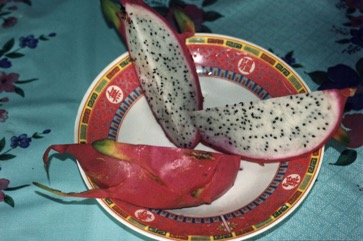
A tropical plant. It grows best in dry tropical and subtropical climates. It suits the lowlands. It needs good light. It suits areas where rainfall is 500-1250 mm per year. It is best in seasonally wet and dry climates. In wet tropical zones plants may grow well but have trouble setting fruit. It needs a temperature above 13°C to grow. It can tolerate temperatures to 40°C and light frosts. It suits hardiness zones 10-12. In Yunnan.
Also known as:
Chacam, Chak-wob, Flor de caliz, Junco tapatio, Mugatta, Night blooming cereus, Pitahaya, Pitaia-branca, Pitaia-vermelha, Pitaya orejona, Pitaya, Pratiel puehs, Queen of the night, Reina de la noche, Strawberry pear, Tasajo, Thanhlong, Thang loy, Tuonglien, Utchimamarunthu, Zacamb
Synonyms
- Cereus undatus Haw.
- Cereus trigonus var. guatemalensis Weing.
- Cereus tricostatus Rol.-Gosselin
- Hylocereus tricostatus (Gosselin) Britton & Rose
- Hylocereus undatus (Haw.) Britton
- and others
Edible Portion
- Fruit, Seeds, Flowers, Vegetable, Stems
Where does Dragon fruit grow?
Found in: Africa, Asia, Australia, Bahamas, Bangladesh, Belize, Bermuda, Brazil, Cambodia, Central America, China, Colombia, Costa Rica, Cuba, Dominican Republic, East Africa, El Salvador, Guam, Guatemala, Hawaii, Indochina, Israel, Jamaica, Marquesas, Mauritius, Mexico, Mozambique, Nauru, New Caledonia, Nicaragua, North America, Pacific, Puerto Rico, Reunion, SE Asia, Singapore, Solomon Islands, South America, Sri Lanka, St. Vincent and Grenadines, Taiwan, Tunisia, Tuvalu, United States, Vietnam, West Indies
Notes: There are 18-24 Hylocereus species. Fruit are high in folates 36μg/100.
Status: It is widely cultivated. The fruit are widely sold in markets. The dried flowers are sold in Chinese shops in Australia.
Growing Dragon fruit
Cultivation: Plants can be grown by seed or stem cuttings. The cuttings are usually dried out for a week or two. The plants are self sterile and have to be pollinated by bats and moths. Hand pollination is recommended for good fruit production.
Edible Uses: The fruit is eaten fresh. It is also used for drinks. A syrup of the fruit is used to colour pastries and candy. The unopened flower buds are cooked and eaten as a vegetable. They are used in soups. The young tender stems with leaves are plucked and eaten as a vegetable.
Production: They can have 4-6 fruiting cycles per year. The fruit weigh 300-800 g.
Nutrition Info
per 100g edible portion| Edible Part | Energy (kcal) | Protein (g) | Iron (mg) | Vitamin A (ug) | Vitamin c (mg) | Zinc (mg) | % Water |
|---|---|---|---|---|---|---|---|
| Fruit | - | 0.5 | 0.4 | - | 25 | - | 89.4 |
Dragon fruit Photos

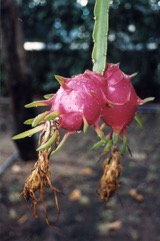
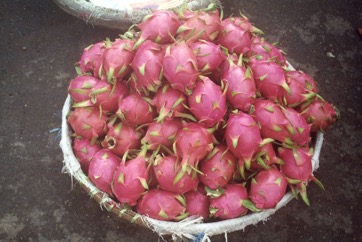
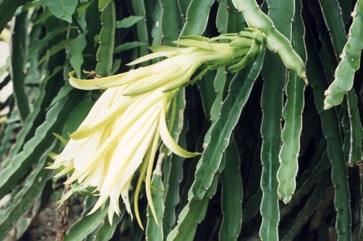
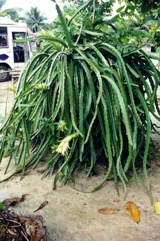
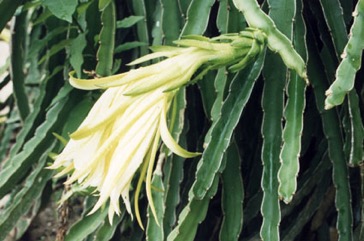
References
Andersohn, G., 1983, Cacti and Succulents. EP Publishing. p 217 (As Hylocereus undatus)
Anderson, E.F., 2001, The Cactus Family, Timber Press. p 56, 381 (As Hylocereus undatus)
Arellanes, Y., et al, 2013, Influence of traditional markets on plant management in the Tehuacan Valley. Journal of Ethnobiology and Ethnomedicine 9:38 (As Hylocereus undatus)
Brickell, C. (Ed.), 1999, The Royal Horticultural Society A-Z Encyclopedia of Garden Plants. Convent Garden Books. p 541 (As Hylocereus undatus)
N. L. Britton, Fl. Bermuda 256. 1918 (As Hylocereus undatus)
Cruz, I. M., et al, 2015, Edible fruits and seeds in the State of Mexico. Revista Mexicana de Ciencias Agricolas. Vol. 6. Num. 2 pp 331-346 (As Hylocereus undatus)
Cundall, P., (ed.), 2004, Gardening Australia: flora: the gardener's bible. ABC Books. p 720 (As Hylocereus undatus)
Darley, J.J., 1993, Know and Enjoy Tropical Fruit. P & S Publishers. p 17 (As Hylocereus undatus)
Facciola, S., 1998, Cornucopia 2: a Source Book of Edible Plants. Kampong Publications, p 64 (As Hylocereus undatus)
FAO, 1993, Valor Nutritivo Y Usis en Alimantacion humana de Algunis Cultivos Autoctonos Subexplotados de Mesoamerica. FAO, Santiago, Chile. p 25 (As Hylocereus undatus)
Flora of Australia, Volume 4, Phytolaccaceae to Chenopodiaceae, Australian Government Publishing Service, Canberra (1984) p 76 (As Hylocereus undatus)
Flora of China. www.eFloras.org (As Hylocereus undatus)
Hermandez Bermejo, J.E., and Leon, J. (Eds.), 1994, Neglected Crops. 1492 from a different perspective. FAO Plant Production and Protection Series No 26. FAO, Rome. p14 (As Hylocereus undatus)
Hibbert, M., 2002, The Aussie Plant Finder 2002, Florilegium. p 145 (As Hylocereus undatus)
Hu, Shiu-ying, 2005, Food Plants of China. The Chinese University Press. p 567 (As Hylocereus undatus)
Innes, C. and Glass, C., 1997, The Illustrated Encyclopedia of Cacti. Sandstone Books. p 140 (As Hylocereus undatus)
Karthi, Sathya, & Salome, 2014, Uncultivated Edible Greens from Small Millet Farms Tamil Nadu India. IDRC (As Hylocereus undatus)
Kiple, K.F. & Ornelas, K.C., (eds), 2000, The Cambridge World History of Food. CUP p 1836 (As Hylocereus undatus)
Lazarides, M. & Hince, B., 1993, Handbook of Economic Plants of Australia, CSIRO. p 134 (As Hylocereus undatus)
Le Bellec, F., et al, 2006, Pitahaya (Hylocereus spp.): a new fruit crop, a market with a future. Fruits, Vol 61, p 237-250 (As Hylocereus undatus)
Liu, Yi-tao, & Long, Chun-Lin, 2002, Studies on Edible Flowers Consumed by Ethnic Groups in Yunnan. Acta Botanica Yunnanica. 24(1):41-56 (As Hylocereus undatus)
Llamas, K.A., 2003, Tropical Flowering Plants. Timber Press. p 165 (As Hylocereus undatus)
Lorenzi, H., Bacher, L., Lacerda, M. & Sartori, S., 2006, Brazilian Fruits & Cultivated Exotics. Sao Paulo, Instituto Plantarum de Estuados da Flora Ltda. p 370 (As Hylocereus undatus)
Lyle, S., 2006, Discovering fruit and nuts. Land Links. p 249 (As Hylocereus undatus)
Martin, F. W., et al, 1987, Perennial Edible Fruits of the Tropics. USDA Handbook 642 p 22, 87 (As Hylocereus undatus)
Miguel, E., et al, 1989, A checklist of the cultivated plants of Cuba. Kulturpflanze 37. 1989, 211-357 (As Hylocereus undatus)
Morton, Julia F., 1987, Fruits of Warm Climates. Creative Resources Systems, Inc. . p. 347 (As Hylocereus undatus)
Pasha, M. K. & Uddin, S. B., 2019, Minor Edible Fruits of Bangladesh. Bangladesh J. Plant Taxon. 26(2): 299–313 (As Hylocereus undatus)
Pham-Hoang Ho, 1999, An Illustrated Flora of Vietnam. Nha Xuat Ban Tre. p 721 (As Hylocereus undatus)
Phon, P., 2000, Plants used in Cambodia. © Pauline Dy Phon, Phnom Penh, Cambodia. p 354 (As Hylocereus undatus)
Recher, P, 2001, Fruit Spirit Botanical Gardens Plant Index. www.nrg.com.au/~recher/ seedlist.html p 2 (As Hylocereus undatus)
Segura, S. et al, 2018, The edible fruit species in Mexico. Genet Resour Crop Evol (2018) 65:1767–1793 (As Hylocereus undatus)
Staples, G.W. and Herbst, D.R., 2005, A tropical Garden Flora. Bishop Museum Press, Honolulu, Hawaii. p 213 (Drawing) (As Hylocereus undatus)
Striegel, L., et al, 2019, Promising Tropical Fruits High in Folates. Foods 2019, 8, 363; doi:10.3390/foods8090363. www.mdpi.com/journal/foods (As Hylocereus undatus)
Thaman, R. R, 2016, The flora of Tuvalu. Atoll Research Bulletin No. 611. Smithsonian Institute p 74 (As Hylocereus undatus)
Turreira-Garcia, N., et al, 2015, Wild edible plant knowledge, distribution and transmission: a case study of the Achi Mayans of Guatemala. Journal of Ethnobiology and Ethnomedicine. 11:52 (As Hylocereus undatus)
USDA, ARS, National Genetic Resources Program. Germplasm Resources Information Network - (GRIN). [Online Database] National Germplasm Resources Laboratory, Beltsville, Maryland. Available: www.ars-grin.gov/cgi-bin/npgs/html/econ.pl (10 April 2000) (As Hylocereus undatus)
van Wyk, B., 2005, Food Plants of the World. An illustrated guide. Timber press. p 212 (As Hylocereus undatus)
World Checklist of Useful Plant Species 2020. Royal Botanic Gardens, Kew (As Selenicereus undatus)
www.colecionandofrutas.org (As Hylocereus undatus)